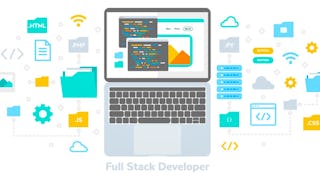Filter by
SubjectRequired
LanguageRequired
The language used throughout the course, in both instruction and assessments.
Learning ProductRequired
LevelRequired
DurationRequired
SkillsRequired
SubtitlesRequired
EducatorRequired
Explore the Elastic Stack Course Catalog
 Status: NewStatus: Free Trial
Status: NewStatus: Free TrialSkills you'll gain: DevOps, CI/CD, Application Deployment, Cloud Development, Development Environment, Cloud Applications, Continuous Deployment, Version Control, Amazon Elastic Compute Cloud, Continuous Integration, Real Time Data, Kibana, Query Languages, Data Modeling, Distributed Computing, SQL, Data Mapping, NoSQL, Event-Driven Programming, Relational Databases
 Status: Free Trial
Status: Free TrialSkills you'll gain: Data Import/Export, Data Visualization Software, Operational Databases, Data Visualization, Data Management, Interactive Data Visualization, Data Mapping, Database Design, Scalability, Histogram, NoSQL, Query Languages, Data Transformation, Amazon Web Services, Data Processing, Cloud Platforms, Apache Kafka, System Monitoring, Application Performance Management, Cloud Computing
 Status: Free Trial
Status: Free TrialMicrosoft
Skills you'll gain: CI/CD, GitHub, C# (Programming Language), HTML and CSS, Load Balancing, Continuous Integration, Git (Version Control System), Role-Based Access Control (RBAC), Scalability, Object Oriented Programming (OOP), Authentications, ASP.NET, Full-Stack Web Development, Web Development, Debugging, SQL, Application Deployment, Microsoft Copilot, .NET Framework, Graph Theory
 Status: Free TrialStatus: AI skills
Status: Free TrialStatus: AI skillsSkills you'll gain: Prompt Engineering, CI/CD, Software Development Life Cycle, Cloud-Native Computing, Software Architecture, Istio, Cloud Computing Architecture, Application Deployment, Kubernetes, React Redux, Node.JS, Responsive Web Design, Restful API, Django (Web Framework), Git (Version Control System), Server Side, Hypertext Markup Language (HTML), Cloud Computing, Data Import/Export, Engineering Software
 Status: NewStatus: Free Trial
Status: NewStatus: Free TrialSkills you'll gain: TypeScript, Object Oriented Design, Node.JS, Role-Based Access Control (RBAC), Object Oriented Programming (OOP), Authentications, React Redux, Back-End Web Development, React.js, Full-Stack Web Development, Web Development, MongoDB, Front-End Web Development, Javascript, Application Programming Interface (API), Software Design Patterns, API Design, Programming Principles, Software Development, Debugging
 Status: Free Trial
Status: Free TrialSkills you'll gain: Responsive Web Design, Cascading Style Sheets (CSS), Web Development, Javascript, Bootstrap (Front-End Framework), Scripting, Browser Compatibility, Application Programming Interface (API), Back-End Web Development
What brings you to Coursera today?
 Status: Free Trial
Status: Free TrialSkills you'll gain: Node.JS, Server Side, Full-Stack Web Development, Back-End Web Development, Cloud Applications, Web Development, Restful API, Web Applications, Web Servers, Authentications, Javascript, Application Programming Interface (API), Computer Science, JSON, Middleware
 Status: Free Trial
Status: Free TrialSkills you'll gain: React Redux, React.js, JavaScript Frameworks, Front-End Web Development, Full-Stack Web Development, UI Components, Web Applications, Web Development, Javascript, Event-Driven Programming, Cascading Style Sheets (CSS), Data Structures
 Status: NewStatus: Free Trial
Status: NewStatus: Free TrialSkills you'll gain: Jest (JavaScript Testing Framework), Django (Web Framework), Version Control, Restful API, Responsive Web Design, Cascading Style Sheets (CSS), Unix Commands, HTML and CSS, Git (Version Control System), GitHub, Relational Databases, Object Oriented Programming (OOP), Database Management Systems, Bootstrap (Front-End Framework), React.js, Mobile Development, SQL, Database Design, API Design, Python Programming
 Status: Free Trial
Status: Free TrialSkills you'll gain: Cascading Style Sheets (CSS), User Experience Design, User Interface and User Experience (UI/UX) Design, User Experience, Design Research, Linux Commands, User Centered Design, Debugging, User Interface (UI), UI Components, Software Versioning, Software Visualization, Web Content Accessibility Guidelines, Pseudocode, JavaScript Frameworks, Javascript, Web Applications, Unit Testing, Application Programming Interface (API), Application Development
 Status: NewStatus: Free Trial
Status: NewStatus: Free TrialSkills you'll gain: Restful API, Spring Boot, Full-Stack Web Development, React.js, IntelliJ IDEA, Object-Relational Mapping, Web Services, JavaScript Frameworks, Integrated Development Environments, Front-End Web Development, YAML, Web Applications, Back-End Web Development, Data Access, User Interface (UI), MongoDB, Application Programming Interface (API), UI Components, JSON, Databases
 Status: Free Trial
Status: Free TrialBoard Infinity
Skills you'll gain: Angular, Node.JS, Full-Stack Web Development, HTML and CSS, User Interface (UI), Application Deployment, Back-End Web Development, Javascript, MongoDB, User Interface (UI) Design, Front-End Web Development, Web Applications, JavaScript Frameworks, Scalability, Restful API, Middleware, Bootstrap (Front-End Framework), jQuery, Databases, Cascading Style Sheets (CSS)
Elastic Stack learners also search
In summary, here are 10 of our most popular elastic stack courses
- Elastic Stack Mastery with Elasticsearch & AWS: EDUCBA
- Elasticsearch 8 and the Elastic Stack: In-Depth and Hands-On: Packt
- Microsoft Full-Stack Developer: Microsoft
- IBM Full Stack Software Developer: IBM
- Modern Web Development with TypeScript: Edureka
- Introduction to HTML, CSS, & JavaScript: IBM
- Developing Back-End Apps with Node.js and Express: IBM
- Developing Front-End Apps with React: IBM
- Meta Full Stack Developer: Front-End & Back-End from Scratch: Meta
- Meta Front-End Developer: Meta










